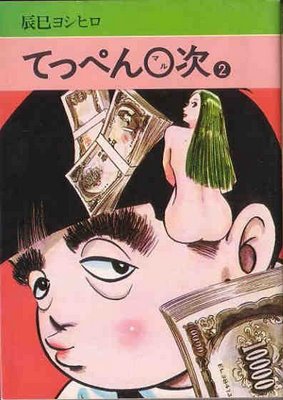Kramers Ergot 7 opens with the denoument and ends with the descent. Sammy Harkham’s front cover shows an idyll after the apocalypse, while Shary Boyle’s back cover shows a leap into Hell. Or just a volcano’s less epic torments. So the book points to a narrative scale equalling its size. A few of the pieces inside (Ryan, Hernandez) can’t be asked, others just go for epic images (stunning works by Xavier Robel and Will Sweeney). The best mix grand stories with grand images.
Two in particular tell whole epics in their two or three pages. The first, a delightful sad myth by Shary Boyle, follows a bride cursed with a dead groom and an elephant mask. As these things go, she sets out to find a graveyard. Like leathery elephant skin, caves and nighttime enclose youth’s bright colors. There she finds an old Bavarian, blood-stained linens, and the crone of the moon. After a mere two pages, the final couple of panels are deeply moving. You’ve been somewhere. This is a old folktale, one with their full complexity, a myth with no dust. The title? “Grow Old.”
The second visits Kim Deitch’s America. Some years ago he met a man who’d known Louie Armstrong. The man was a counterculture visionary, aiming to create a whole new culture in the underground. His startup mixed LSD sodas until the Man put him down. He fled, only to be found years later mummified on a boat with his last disciple, still tripping. (This all has to be true.) Bottlecaps sprinkled in the margins tie the whole together. It hints at those quintessentially American stories: the Hardy Boys, Terrytoons, Horatio Alger. For all the graphic bravado in Kramers, Deitch’s piece left me the most slackjawed. It’s a creation myth with destruction besides for one generation of Americans. Its images burned into my eyes, and Deitch wraps it in layers and layers of tawdry pop culture whose meanings open up and out.
Both these stories strike me as myths in the best sense. They’re origin stories. The details of a character’s life get hoisted onto a larger stage and bleached by the lights. The song & dance tell us who we are. Compare Tom Gauld’s version of Noah’s Ark in Kramers, where myth’s emptied so that Shem and Ham can gripe about their crazy dad. Gauld’s story pits the grand scale of Noah’s project, drawn in huge tableaux, against smaller panels sized for his kids’ complaints. The entire hassle of listening to God, who knows who you are and what you should do, gets drawn as a Rube Goldberg contraption with animals two by two. Shem & Ham can’t be bothered. Once they’re surrounded by the flood, they can’t understand how Noah was right after all. Gauld’s vision is contemporary: even if there’s a miracle, it just won’t scan. Without seeming fusty, Boyle & Deitch tap into something primordial.
Of course, calling things myths can get out of hand. Some weeks ago, someone around here (me?) took a swipe at Joseph Campbell– a critic I haven’t read in some time as I feel I know him too well. He’s the guy whose ideas, a stew of Jungian archetypes and Perennialism, gave screenwriters a way to sound more important. The prime mover there is Star Wars, a Western I grew up on. I loved it; it’s vivid enough in my memory that I haven’t revisited it for years. To hear 1000 faces talk, though, it’s the Iliad teamed up with the Mahabharata.
I’ve never been comfortable with that reading. The film, along with its sequels, imitators and any other screenplay mainlining Campbell and Robert McKee, tells me all about the stuff George Lucas grew up on rather than the place he grew up. (You have to go to American Graffiti for that.) Star Wars reads as John Ford-via-Kurosawa, Errol Flynn, everything a middle-class kid or film student would know. He wouldn’t know the veins flowing beneath John Ford’s work, though, the details in the archetypes. I think of my parents’ generation, who spent very little time in front of a screen, but got Westerns in a way I can’t. Go out and tame the wild, bend nature, build dams and damned superhighways. They’re America’s creation myth.
My generation couldn’t be asked. Everything was built for us, so our stories often trade bleached-out details for no details at all. Fortunately, Joe Campbell’s there to give us a reason why. Yet his entire project differs considerably from the aesthetic shorthand it’s become. A poorly drawn character’s backstory becomes “mythos,” when “mythos” should refer just to the fundament Campbell believed was common to all. How odd that now creation myths like the Western have given way to Life After People, three dozen climate change movies, or the scrubbing bubbles of civilization-eating zombies. Destroy the foundations, then. Which is why I love the pieces by Deitch and Boyle so much. They’re small gestures, reminders of those delightful, sad ways of feeling human.









